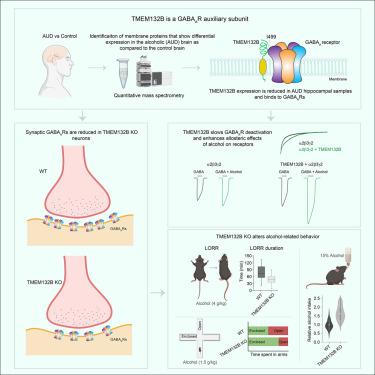The TMEM132B-GABAA receptor complex controls alcohol actions in the brain
IF 45.5
1区 生物学
Q1 BIOCHEMISTRY & MOLECULAR BIOLOGY
引用次数: 0
Abstract
Alcohol is the most consumed and abused psychoactive drug globally, but the molecular mechanisms driving alcohol action and its associated behaviors in the brain remain enigmatic. Here, we have discovered a transmembrane protein TMEM132B that is a GABAA receptor (GABAAR) auxiliary subunit. Functionally, TMEM132B promotes GABAAR expression at the cell surface, slows receptor deactivation, and enhances the allosteric effects of alcohol on the receptor. In TMEM132B knockout (KO) mice or TMEM132B I499A knockin (KI) mice in which the TMEM132B-GABAAR interaction is specifically abolished, GABAergic transmission is decreased and alcohol-induced potentiation of GABAAR-mediated currents is diminished in hippocampal neurons. Behaviorally, the anxiolytic and sedative/hypnotic effects of alcohol are markedly reduced, and compulsive, binge-like alcohol consumption is significantly increased. Taken together, these data reveal a GABAAR auxiliary subunit, identify the TMEM132B-GABAAR complex as a major alcohol target in the brain, and provide mechanistic insights into alcohol-related behaviors.

TMEM132B-GABAA受体复合物控制大脑中的酒精作用
酒精是全球消费和滥用最多的精神活性药物,但驱动酒精作用及其在大脑中相关行为的分子机制仍然是个谜。在这里,我们发现了一种跨膜蛋白 TMEM132B,它是 GABAA 受体(GABAAR)的辅助亚基。在功能上,TMEM132B 促进 GABAAR 在细胞表面的表达,减缓受体失活,并增强酒精对受体的异构效应。在 TMEM132B 基因敲除(KO)小鼠或 TMEM132B I499A 基因敲除(KI)小鼠中,TMEM132B-GABAAR 的相互作用被特异性地废除,海马神经元中的 GABA 能传导减少,酒精诱导的 GABAAR 介导电流的增效作用减弱。在行为上,酒精的抗焦虑和镇静/催眠作用明显减弱,强迫性、狂欢式饮酒明显增加。总之,这些数据揭示了一种 GABAAR 辅助亚基,确定了 TMEM132B-GABAAR 复合物是大脑中的主要酒精靶标,并提供了对酒精相关行为的机理认识。
本文章由计算机程序翻译,如有差异,请以英文原文为准。
求助全文
约1分钟内获得全文
求助全文
来源期刊

Cell
生物-生化与分子生物学
CiteScore
110.00
自引率
0.80%
发文量
396
审稿时长
2 months
期刊介绍:
Cells is an international, peer-reviewed, open access journal that focuses on cell biology, molecular biology, and biophysics. It is affiliated with several societies, including the Spanish Society for Biochemistry and Molecular Biology (SEBBM), Nordic Autophagy Society (NAS), Spanish Society of Hematology and Hemotherapy (SEHH), and Society for Regenerative Medicine (Russian Federation) (RPO).
The journal publishes research findings of significant importance in various areas of experimental biology, such as cell biology, molecular biology, neuroscience, immunology, virology, microbiology, cancer, human genetics, systems biology, signaling, and disease mechanisms and therapeutics. The primary criterion for considering papers is whether the results contribute to significant conceptual advances or raise thought-provoking questions and hypotheses related to interesting and important biological inquiries.
In addition to primary research articles presented in four formats, Cells also features review and opinion articles in its "leading edge" section, discussing recent research advancements and topics of interest to its wide readership.
 求助内容:
求助内容: 应助结果提醒方式:
应助结果提醒方式:


